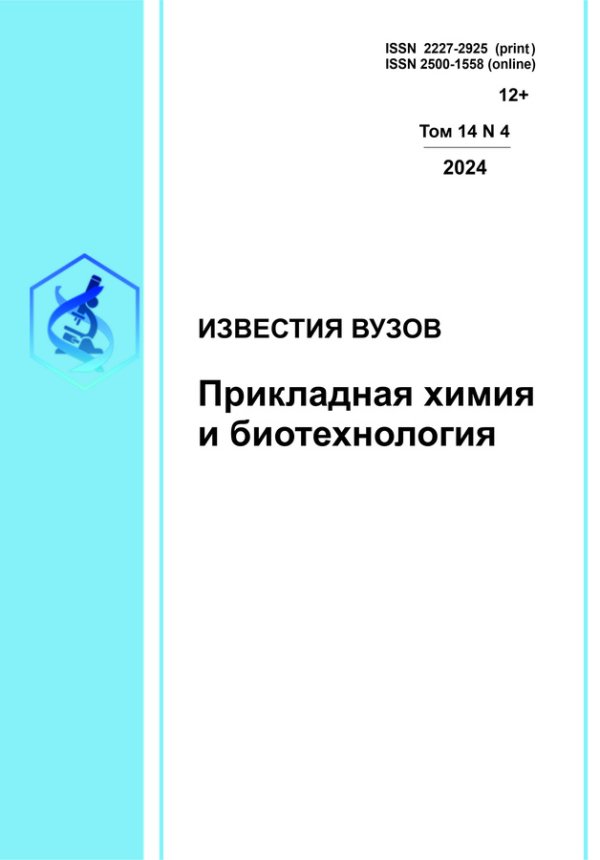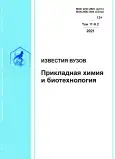Неподелённая электронная пара сурьмы как стереоэлектронный барьер на пути к стибатрану
- Авторы: Барышок В.П.1, Зельбст Э.А.2
-
Учреждения:
- Иркутский национальный исследовательский технический университет
- Педагогический институт Иркутского государственного университета
- Выпуск: Том 11, № 2 (2021)
- Страницы: 178-186
- Раздел: Химические науки
- URL: https://ogarev-online.ru/2227-2925/article/view/300909
- DOI: https://doi.org/10.21285/2227-2925-2021-11-2-178-186
- ID: 300909
Цитировать
Полный текст
Аннотация
Об авторах
В. П. Барышок
Иркутский национальный исследовательский технический университет
Email: baryvik@yandex.ru
Э. А. Зельбст
Педагогический институт Иркутского государственного университета
Email: zelbst@rambler.ru
Список литературы
- Voit E.I., Udovenko A.A., Kovaleva E.V., Makarenko N.V., Zemnukhova L.A., Beleneva I.A. Structure and properties of the molecular complex of antimony(III) fluoride with Y-glycine // Journal of Structural Chemistry. 2019. Vol. 60. Issue 4. P. 630-639. https://doi.org/10.1134/S0022476619040140
- Ковалева Е.В., Макаренко Н.В., Удовенко А.А., Земнухова Л.А. Синтез, строение и свойства фторидных комплексных соединений сурьмы(111) с аминокислотами // Вестник Дальневосточного отделения Российской академии наук.2019. N 6 (208). С. 5-22. https://doi.org/10.25808/08697698.2019.208.6.001
- Udovenko A.A., Makarenko N.V., Kovaleva E.V., Zemnukhova L.A. Crystal structure of DL-valinium tetrafluoroantimonate(III) monohydrate // Journal of Structural Chemistry. 2018. Vol. 59. Issue 7. P. 1653-1657. https://doi.org/10.1134/S0022476618070181
- Udovenko A.A., Makarenko N.V., Kovaleva E.V., Zemnukhova L.A. Crystal structure of DL-serinium heptafluorodiantimonate(III) // Journal of Structural Chemistry. 2018. Vol. 59. Issue 6. P. 1421-1426. https://doi.org/10.1134/S0022476618060240
- Benjamin S.L., Burt J., Levason W., Reid G., Webster M. Synthesis and structures of antimony trifluoride complexes with N-heterocyclic ligands // Journal of Fluorine Chemistry. 2012. Vol. 135. P. 108-113. https://doi.org/10.1016/j.jfluchem.2011.09.007
- Udovenko A.A., Makarenko N.V., Davidovich R.L., Zemnukhova L.A., Kovaleva E.V. Crystal structure of the molecular adduct of antimony(III) fluoride with L-phenylalanine // Journal of Structural Chemistry. 2011. Vol. 52. Issue 3. P. 616-620. https://doi.org/10.1134/S0022476611030243
- Khan M., Gul S., Hussain I., Khan M.A., Ashfaq M., Inayat-Ur-Rahman, et al. In vitro anti-leishmanial and anti-fungal effects of new Sb(III) carboxylates // Organic and Medicinal Chemistry Letters. 2011. Vol. 1. Issue 2. 7 p. https://doi.org/10.1186/2191-2858-1-2
- Udovenko A.A., Davidovich R.L., Zemnu-khova L.A., Kovaleva E.V., Makarenko N.V. Crystal structure of DL-serinium tetrafluoroantimonate(III) // Journal of Structural Chemistry. 2010. Vol. 51. Issue 3. P. 540-544. https://doi.org/10.1007/s10947-010-0078-z
- Udovenko A.A., Makarenko N.V., Davidovich R.L., Zemnikhova L.A., Kovaleva E.V. Crystal structure of L-leucinium tetrafluoroantimonate(III) // Journal of Structural Chemistry. 2010. Vol. 51. Issue 5. P. 904-908. https://doi.org/10.1007/s10947-010-0137-5
- Voronkov M.G., Pestunovich V.A., Alba-nov A.I., Kuznetsova G.A., Selbst E.A., Baryshok V.P. 1-Fluoro-2-hydrostibatrane // Journal of Structural Chemistry. 2006. Vol. 47. Issue 3. P. 527-531. https://doi.org/10.1007/s10947-006-0332-6
- Zemnukhova L.A., Davidovich R.L., Udovenko A.A., Kovaleva E.V. Sb(III) fluoride complexes with DL-valine. Crystal structure of molecular complex SbF3{(Ch3)2ChCh(+Nh3)COO-} // Russian Journal of Coordination Chemistry. 2005. Vol. 31. Issue 2. P. 115-120. https://doi.org/10.1007/S11173-005-0040-3
- Tanski J.M., Kelly B.V., Parkin G. Multidentate aryloxide and oxo-aryloxide complexes of antimony: synthesis and structural characterization ofSb(OSMe2), {{Sb}2(p2-O)}2 and {Sb}4 (p3-O)2 // Dalton Transactions. 2005. Issue 14. P. 24422447. https://doi.org/10.1039/b505308k
- Udovenko A.A., Zemnukhova L.A., Kovaleva E.V., Davidovich R.L. Crystal structure of monohydrate and anhydrous в-alaninium tetrafluoroanti-monates(III) // Russian Journal of Coordination Chemistry. 2005. Vol. 31. Issue 4. P. 225-229. https://doi.org/10.1007/s11173-005-0081-7
- Voronkov M.G., Pestunovich V.A., Zelbst E.A., Kashaev A.A., Fundamenskiy V.S., Albanov A.I., et al. The puzzle of stibatrane: (O >Sb< N)-2-Fluoro-6-(2''-hydroxyethyl)-1,3-dioxa-6-aza-2-stibacyclooctane // Doklady Chemistry. 2001. Vol. 381. Issue 4-6. P. 344346. https://doi.org/10.1023/A:1013316824768
- Singh A.K., Amburosea C.V., Jha N.K., Sharma P., Cabrera A., Espinosa-Perz G.: synthesis and crystal structure // Journal of Chemical Research. 2000. Issue 4. P. 198-199. https://doi.org/10.3184/030823400103166959
- Zemnukhova L.A., Davidovich R.L. 121,123Sb NQR study of antimony(III) fluoride complexes // Russian Chemical Bulletin. 1998. Vol. 47. Issue 11. P. 2164-2168. https://doi.org/10.1007/BF02494273
- Battaglia L.P., Corradi A.B., Pelosi G., Cantoni A., Alonzo G., Bertazzi N. Crystal and molecular structure of antimony trifluoride-terpyridine 1:1 adduct: a case of pseudo-pentagonal-bipyramidal geometry // Journal of the Chemical Society, Dalton Transactions. 1991. Vol. 11. P. 3153-3155. https://doi.org/10.1039/DT9910003153
- Abboud K.A., Palenik R.C., Palenik G.J., Wood R.M. Syntheses and structures of four antimony complexes with planar tridentate pyridine ligands // Inorganica Chimica Acta. 2007. Vol. 360. Issue 11. P. 3642-3646. https://doi.org/10.1016/j.ica.2007.05.007
- Voronkov M.G., Baryshok V.P. Metallatranes // Journal of Organometallic Chemistry. 1982. Vol. 239. Issue 1. P. 199-249.
- Bradiey D.C., Gaur D.P., Mehrotra R.C. Metal Alkosides. London: Academic Press, 1978. 411 p.
- Muller R. The splitting of the 1-organyl-silatranes by metal fluorides // Organometallic Chemistry Reviews. 1966. Vol. 1. P. 359.
- Das R., Pani S. Trichloromonopyridineantimony complex // Journal of the Indian Chemical Society. 1954. Vol. 33. P. 538.
- Keogan D.M., Oliveira S.S.C., Sangenito L.S., Branquinha M.H., Jagoo R.D., Twamley B., et al. Novel antimony(III) hydroxamic acid complexes as potential anti-leishmanial agents // Dalton Transactions. 2018. Vol. 47. Issue 21. P. 72457255. https://doi.org/10.1039/C8DT00546j
- Urgut O.S., Ozturk I.I., Banti C.N., Kourkoumelis N., Manol M., Tasiopoulos A.J., et al. New antimony(III) halide complexes with dithiocarbamate ligands derived from thiuram degradation: The effect of the molecule's close contacts on in vitro cytotoxic activity // Materials Science and Engineering: C. 2016. Vol. 58. P. 396-408. https://doi.org/10.1016/j.msec.2015.08.030
- Hadjikakou S.K., Ozturk I.I., Banti C.N., Kourkoumelis N., Hadjiliadis N. Recent advances on antimony(III/V) compounds with potential activity against tumor cells // Journal of Inorganic Biochemistry. 2015. Vol. 153. P. 293-305. https://doi.org/10.1016/j.jinorgbio.2015.06.006
- Ozturk I.I., Urgut O., Banti C.N., Kourkoumelis N., Owczarzak A.M., Kubicki M., et al. Synthesis, structural characterization and cytostatic properties of N,N-dicyclohexyldithiooxamide complexes of antimony(III) halides (SbX3, X: Br or I) // Polyhedron. 2014. Vol. 70. P. 172-179. https://doi.org/10.1016/j.poly.2013.12.025
- Tiekink Е.Р.Т. Anticancer activity of molecular compounds of arsenic, antimony and bismuth. In: Biological chemistry of arsenic, antimony and bismuth. Ed. Sun. H. Chichester. UK: John Willey & Sons Ltd, 2011, pp. 293-310. https://doi.org/10.1002/9780470975503.ch12
- Ковалева Е.В., Земнухова Л.А. Экотокси-кологические свойства комплексных фторидных соединений сурьмы(Ш) // Вестник Томского государственного университета. Химия. 2019. N 13. C. 28-41. https://doi.org/10.17223/24135542/13/4
- Adeyemi J.O., Onwudiwe D.C. Chemistry and Some Biological Potential of Bismuth and Antimony Dithiocarbamate Complexes // Molecules. 2020. Vol. 25. Issue 2. P. 305-326. https://doi.org/10.3390/molecules25020305
- Pestunovich V.K., Kirpichenko S.V., Voronkov M.G. Silatranes and their tricyclic analogs. In: Saul P., Rappoport Z., Apeloig Y. (eds.) Chemistry of organic silicon compounds. Vol 2. Part 2. Chichester: Wiley, 1998, pp 1447-1537.
- Sterkhova I.V., Smirnov V.I., Kuznetsova G.A., Zel'bst E.A. Crystal and molecular structure of 1-(iodmethyl)- and 1-(iodpropyl)silatranes // Journal of Structural Chemistry. 2016. Vol. 57. Issue 1. P. 209212. https://doi.org/10.1134/S0022476616010285
- Харгиттаи М., Харгиттаи И. Геометрия молекул координационных соединений в парообразной фазе / пер. с англ. В.П. Спиридонова. М.: Мир, 1976. 248 c.
- Pauling L. The nature of the chemical bond. Ithaca: Cornell University Press, 1960. 644 p.
- Бацанов С.С. Атомные радиусы элементов // Журнал неорганической химии. 1991. Т. 36. N 12. С. 3015-3037.
- Воронов В.К., Дударева О.В., Фунтикова Е.А. Исследования комплексов ZnCl2 и CdCl2 с триэтаноламином методами спектроскопии ЯМР и квантовой химии // Известия вузов. Прикладная химия и биотехнология. 2020. Т. 10. N 4. С. 548555. https://doi.org/10.21285/2227-2925-2020-10-4-548-555
- Kupce E., Liepins E., Lukevics E. The conflict between the conformational properties of the eight-membered heterocycle and trigonal bipyramid of fire-coordinated silicon in 1,3-dioxa-6-aza-2-silacycleoctanes // Journal of Organometallic Chemistry. 1983. Vol. 248. Issue 2. P. 131-147. https://doi.org/10.1016/0022-328X(83)85020-7
Дополнительные файлы










